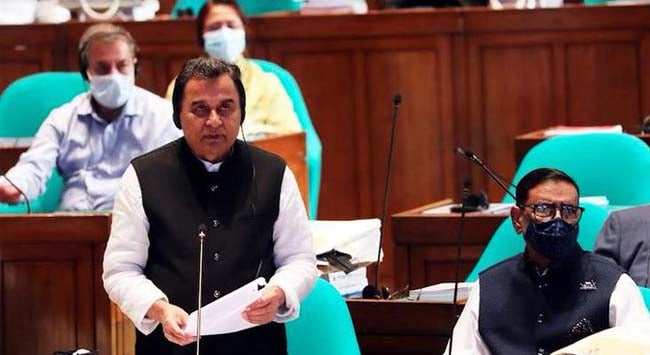Bangladesh Budget FY2022-23: Challenge of
Promoting Growth and Controlling Inflation
Mohammad Masudur Rahman, Divya Murali
16 June 2022Summary
As Bangladesh tries to manage the triple threat of inflation, exchange rate volatility and a widening current account balance, the attempt by the Budget for the fiscal year 2022-23 to balance the levers of growth while simultaneously containing inflation may be challenging.
Bangladesh is in the midst of tackling a number of macro-economic issues, including high inflation, exchange rate volatility and the subsequent widening of the current account balance. These typically require monetary and fiscal policy interventions to work in tandem. Against this backdrop, Bangladesh’s Finance Minister, A H M Mostafa Kamal, presented the Budget for the fiscal year (FY) 2022-23 in parliament on 9 June 2022. The government forecasts a growth rate of 7.5 per cent for FY2022-23 with a gross domestic product (GDP) per capita of US$2,885 (S$4,018).[1] However, a 7.5 per cent GDP growth rate with an inflation target of 5.6 per cent seems ambitious.
While outlining the strategy to control inflation, the finance minister, during his Budget speech said, “…our main strategy for the next fiscal would be to increase supply while reducing growth in demand”. This stems from market pressures where fuel, fertiliser and wheat prices rose by 65 per cent, 114 per cent and 85 per cent respectively in May 2022 compared to May 2021. This was primarily owing to supply shortages arising from the COVID-19 pandemic and the Russia-Ukraine conflict. As a result of the price rise, the country incurred an additional US$8 billion (S$11.14 billion) in import costs. Consequently, Bangladesh suffered a trade deficit of US$24 billion (S$33.43 billion) within the first nine months FY2021-22 (July 2021-March 2022). High import costs lead to high production costs which lead to high inflation. With the commodity markets likely to remain volatile owing to the Russia-Ukraine conflict, inflation will be a greater risk to contend with in the near to medium term and the growth rate will be impacted invariably. In this context, the government’s target of a 7.5 per cent growth rate, while simultaneously managing inflationary pressures, appears challenging. Besides, the foreign exchange markets are extremely volatile now. For example, the Bangladesh Taka (BDT) fell sharply by about 12 per cent[2] within a month in May 2022 and will devalue further due to increasing import costs and oil prices, which will again increase production cost and inflation.
Another reason this balancing act between growth and inflation looks challenging is the widening budget deficit. The budget deficit for FY2022-23 is projected at 5.5 per cent of GDP and domestic borrowings are to finance 60 per cent of this deficit. This has two main implications. The first is when domestic public borrowing increases, it crowds out domestic private borrowings which lead to lower investment and output and a fall in GDP. The second is that increased government appetite to borrow from the banks could lead to the Central Bank adopting an expansionary monetary policy which will result in an increase in money supply and a rise in inflation.
Complicating the larger calculus is the fact that the COVID-19 pandemic is far from over. The pandemic particularly led nations to come out with stimulus packages to support their economies – Bangladesh did too and continues to do so. During his Budget speech, the finance minister said that about 28 financial and incentive packages amounting to BDT1.87 trillion (S$27 billion) were announced as stimulus so far which is 72 per cent of the annual development Budget of FY2022-23.[3] While these packages did help Bangladesh in its economic recovery during the peak of the pandemic, it remains to be seen if the trade-off of economic recovery from these packages outweighs the inflationary risks associated with it.
Besides these issues, another factor that is unique to Bangladesh is the upcoming Least Developed Country (LDC) graduation and the need to strategise policies to deal with its economic implications for the country. As the graduation nears, the Budget did not lay out a roadmap to address this structural change which could significantly affect Bangladesh’s future growth prospects.
As Bangladesh looks to navigate its way out of the economic challenges caused by global market challenges, the pandemic and the upcoming LDC graduation, the balancing act of the Budget for FY2022-23 between growth and inflation looks tricky and perhaps even challenging to achieve.
. . . . .
Dr Mohammad Masudur Rahman is a Visiting Research Fellow at the Institute of South Asian Studies (ISAS), an autonomous research institute at the National University of Singapore (NUS). He can be contacted at masudrahman@nus.edu.sg. Ms Divya Murali is a Research Analyst at the same institute. She can be contacted at divya.m@nus.edu.sg. The authors bear full responsibility for the facts cited and opinions expressed in this paper.
[1] All numbers have been taken from the Budget documents.
[2] The exchange rate is now BDT95 per dollar. It was BDT85 per dollar on 1 May 2022.
[3] The annual development expenditure for FY2022-23 is BDT2.59 trillion (S$37 billion).
Pic Credit: @Awami League
-
 More From :
More From :
-
 Tags :
Tags :
-
 Download PDF
Download PDF



